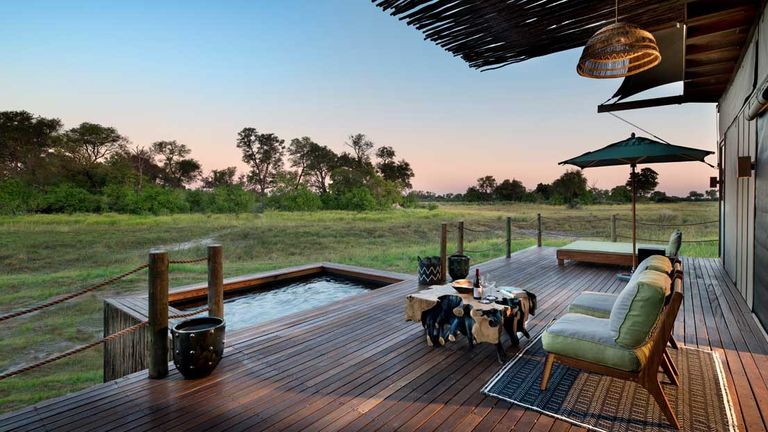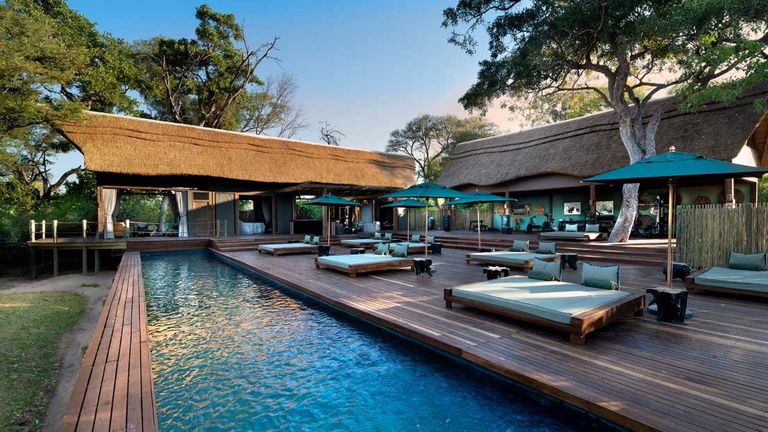Every year, southwest Africa’s Okavango River discharges some 2.5 trillion gallons of water into the dry sands of the Kalahari Desert, creating the Okavango Delta — one of the largest wetlands in the world.
A maze of more than 6,500 square miles of waterways, lagoons, shallow channels, reed islands and grassy floodplains, this delta is home to vast concentrations of wildlife, with more than 1,000 species of plants, 480 species of birds, 130 species of mammals and many species of reptiles and fish. Designated as UNESCO’s 1,000th World Heritage Site and one of the Seven Natural Wonders of Africa, the Okavango Delta is one of the most biodiverse wetlands in the world and undeniably Botswana’s emerald crown jewel.
And I was eager to explore it from the comfort of the luxe Atzaro Okavango Camp, a new safari lodge in Botswana from African Bush Camps.
Luxury in the Delta
As the helicopter rose into the air, leaving behind Maun’s bustling little airport, the town’s buildings, bars, homes and shacks gave way to a patchwork of scrub, bushes, trees, cattle kraals and dried-up waterholes. As we flew over the Buffalo Fence, built in the 1980s to keep buffalo away from domestic cattle, the landscape changed.
Game footpaths and animal highways materialized. We could see pods of hippos in the waterways and families of elephants standing under trees; and the bright blues and greens of the Okavango began to appear. All too soon, the outline of a lodge took shape, and as the helicopter descended towards the earth, a vehicle arrived to transport us to our accommodations.
Overlooking a seasonal lagoon, with a river along one side and surrounded by lush palm islands and vibrant delta vegetation, Atzaro Okavango is a truly stylish safari camp. Eight palatial tented rooms are connected by raised wooden walkways leading off the central area. All have air-conditioning and fans, as well as voluminous mosquito nets draped around the beds.
 There are eight tented rooms at the camp.
There are eight tented rooms at the camp.
Credit: 2024 Atzaro Okavango CampOutside on a private deck, there’s a small, shaded area with a plunge pool — vital for cooling off from the heat of the day. Bathrooms have both indoor and outdoor showers and bathtubs. Two family villas add to the options, with separate rooms linked by a walkway.
The luxury doesn’t stop with the bedrooms. The main thatched lodge area has vaulted ceilings and a large open lounge, with antiques, leather sofas adorned in traditional kuba cloths. The bar is detailed with woods, velvets and cut-glass, and there’s a sunken seating area around an outdoor fire pit, with views overlooking the seasonal lagoon. Guests can take high tea at the observation deck, sip pre-dinner drinks at the bar, then settle in by the fire pit to watch the stars overhead while listening to the grunts of hippos or the sound of elephants coming to drink.
 Interiors have an eclectic look.
Interiors have an eclectic look.
Credit: 2024 Atzaro Okavango CampClients looking for something extra will love the wine cellar, complete with sommelier. For meals, an artfully thatched traditional boma — reminiscent of a bird’s nest — adds a rustic alternative to dinner in the primary dining area. The main lodge also serves as a “living museum” and is filled with a collection of intricate and traditional artwork from all over the continent. However, amongst all this glamour, Atzaro Okavango hasn’t lost focus on its sustainability principles, and the camp uses recycled materials and is fully solar-powered.
Activities and Amenities
It’s no surprise that the range of things to do are exceptional. If clients fancy a workout, they can head to the gym, the swimming pool or the yoga deck. If it’s pampering they're after, there’s a wellness spa offering a variety of treatments (and specializing in some of the best massages I’ve ever had).
 The outdoor firepit at Atzaro Okavango Camp
The outdoor firepit at Atzaro Okavango Camp
Credit: 2024 Atzaro Okavango CampOf course, Atzaro is a safari lodge, so much of the day will doubtless be spent seeking out the wildlife of the delta. This area of the Okavango has high concentrations of game, making for exciting viewing opportunities.
Out one morning, not 10 minutes from camp, we sat silently in the back of the game drive vehicle. Five cheetahs were laying in the grass before us, camouflaged. We had seen these same cheetahs the previous afternoon, resting in a patch of shade; this time, they were on the prowl.
 The plunge pool at Atzaro Okavango Camp
The plunge pool at Atzaro Okavango Camp
Credit: 2024 Atzaro Okavango CampA pair of unsuspecting warthogs and their baby appeared, and the cheetahs’ heads turned in unison — then, suddenly, pandemonium broke out. One cheetah headed toward the warthogs, eyeing the piglet; the other four got to their feet and cornered the family. Breaking into a run, the first cheetah closed in on the baby, and we collectively held our breath. In the face of the charging cheetah, the warthog parents stood their ground before racing toward the approaching cat, who skidded to a halt in a cloud of dust and turned off in the opposite direction. The parents returned, victorious, to gather up their baby.
In addition to exciting morning and afternoon game drives, guests can go on walking safaris (with an armed guide) or go birdwatching. Seasonal water levels permitting, there are boat trips and sunset cruises, catch-and-release fishing and the opportunity to enjoy the gentle pace of mokoro (dugout canoe) excursions. All activities are offered on a private basis.
Planning a Visit to Atzaro Okavango
When to go: The area experiences distinct wet and dry seasons. The dry season sees a moderate climate from May to August — around 68 degrees during the day — while August to October daytime temperatures reach about 82. The wet season is from November to April, and daytime temperatures are around 82 degrees.
Where to stay: Atzaro Okavango Camp is a great standalone destination, but it also combines well with other African Bush Camps properties, particularly the lovely Khwai Leadwood or Khwai Lediba, which are only a short flight away. There's also Linyanti Ebony in the Chobe region of Botswana.
How to prepare: Pack light for an Okavango Delta safari. The maximum luggage allowance for helicopter flights is 44 pounds per person. Relaxed, casual, neutral-colored safari-style clothing is recommended.
Getting there: Atzaro Okavango is only reachable via a short helicopter flight from the Botswanan town of Maun.